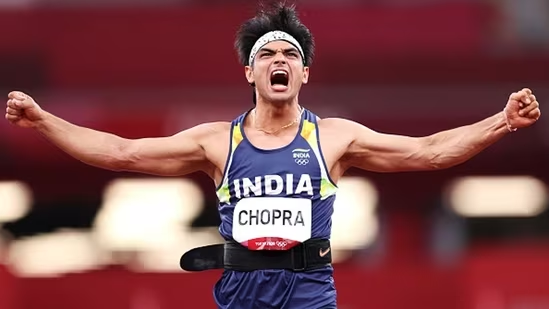87.58m that could change everything
Who knew the answer to life, the universe, and everything was not 42 (as Douglas Adams would have us believe). For Indian sport, it was 87.58.

87.58 metres, to be precise – which Usain Bolt can cover in less than 8.5 seconds on land and Michael Phelps in about 41 seconds in the water – was the distance to immortality.
Neeraj Chopra did it by finding a small pocket in the air and piercing it with his javelin. As the projectile soared, so did 101 years of India’s Olympics history with it. It kept travelling, with complete disregard for the burden of the past and the shackles of what is and isn’t possible. And when it landed, it had pushed the margins forever.
That’s what champions do.
Also Read | Tokyo Olympics: Khandra village erupts in joy after Neeraj gold
India getting an Olympic medal of any colour in track & field seemed impossible enough, given that no one – not even the hallowed pantheon of Milkha Singh, PT Usha and Anju Bobby George -- had managed it*. For that medal to be gold needed a miraculous defiance of all the laws – motion, logic, Murphy’s, you name it.
It happened because that’s what sport is; and particularly because that’s what the Olympics are for. India has finally tasted a slice of the incredible.
Neeraj Chopra was born in 1997, the eldest of three children, in Haryana’s Khandra village to farmer Satish Kumar and his wife Saroj.
When he was 12, Neeraj weighed 80kg. His family, worried that the boy ate anything he could find, and did little to expend the calories, sent him to the gym at the Panchkula Stadium in Panipat, about 15km away. Neeraj was a reluctant starter, but after his perfunctory workout, he’d sit and watch the athletics squad in the stadium – the sprinters would be tearing down the track in one corner, the middle-distance runners doing interval training in another, and, in the distance, some people would be hurling a long spear into the void.
Also Read | Tokyo 2020: Neeraj Chopra scripts history cast in gold
This activity intrigued Neeraj. One day, local javelin thrower, Jaiveer Chaudhary, piqued by the boy’s interest in the sport, asked him to give it a shot instead of watching idly from a distance. Jaiveer realised quickly that throwing the javelin came naturally to Neeraj, and soon they started training together.
The family was delighted by this sudden change in Neeraj – all they wanted was for him to lose weight; they got an athlete instead.
By the time he was 18, Neeraj was making heads turn – with his flowing locks (clipped just before Tokyo 2020), and with the distances he started recording.
He first stunned the field with a throw of over 86m at the world junior championships in the Polish town of Bydgoszcz in 2016. Then came the gold rush – the 2017 Asian Championships in Bhubaneswar, the 2018 Commonwealth Games at Gold Coast, and Asian Games in Jakarta. And then the injury to his throwing arm that needed surgery and could’ve ended his career. Incredible as it makes this story, if the Olympics weren’t delayed by a year, he may not have made it.
The enormity of what Neeraj achieved on Saturday lies not in how this gold has forever taken the track & field monkey off India’s back, but in what this could spark.
Thirteen years ago, India’s first Olympic gold at Beijing by shooter Abhinav Bindra made non-cricket athletes across the country believe that they, too, had a chance. The buzz it created led to six medals in London 2012 (a rich haul given that we were a one-medal nation until Beijing 2008 happened and this was somehow fine with our sports federations), and in more athletes getting into medal-winning positions at Rio 2016.
To keep the momentum going, India’s wish list for Tokyo 2020 had four items in it. In ascending order of difficulty: at least seven medals (to better London); one of them gold (to prove 2008 wasn’t a one-off); one of them in hockey (to end the 41-year drought in a sport we once ruled); and one of them in track & field (to show we could compete in the most fundamental of all Olympic disciplines).
Till the last day of competition, only one out of four boxes were checked.
Then, Neeraj Chopra, spear aimed at the heavens, in a sport first introduced at the Ancient Olympics in 700 BC, gave 87.58 reasons why India’s Olympics march must continue.
(* Englishman Norman Pritchard, born in India, won two silver medals on the track in 1900. The jury on which country they should be credited to has been out for a century. India sent its first full squad to the Olympics in 1920.)
Disclaimer: The copyright of this article belongs to the original author. Reposting this article is solely for the purpose of information dissemination and does not constitute any investment advice. If there is any infringement, please contact us immediately. We will make corrections or deletions as necessary. Thank you.







